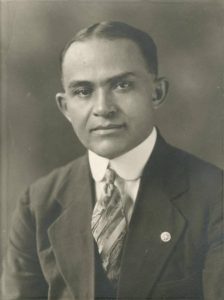
Photo info …
Credit: Indianapolis Recorder Collection, Indiana Historical SocietyView Source
(Apr. 4, 1886-June 27, 1985). Mathias Nolcox was born in Lyles Station, Indiana, in Gibson County, one of Indiana’s early Black rural settlements and the only one remaining as of 2022. He attended Indiana State Normal School (Indiana State University) in Terre Haute, Indiana, through his sophomore year in 1905.
When he was 19 years old, Nolcox became the principal of the high school in Patoka, Indiana. He then pursued more education at Indiana University, earning degrees in chemistry and math in 1910 with the intention of going on to medical school. Nolcox instead later enrolled in graduate studies at the University of California, where he earned a master’s degree in education.
In 1922, Nolcox became principal of (home of Middle School as of 2015). That same year he married Marie Anderson.

When Nolcox began teaching, de facto segregation was widespread in cities like Indianapolis, which had large populations of African Americans. Located in a Black neighborhood, elementary School Number 26 was one such segregated school. However, no official policy of segregation existed in the (IPS) at the time, and Black and white students attended together, especially at its three high schools.
During his first years in Indianapolis, Nolcox took summer courses at Harvard University, earning his Ph.D. in education in 1927. He also went to Europe, where he studied at Oxford University to examine the European educational systems.
In the fall of 1927, Nolcox became the first principal of , a new separate facility for Black students. Construction of Attucks resulted from a December 1922 decision of the IPS Board of School Commissioners that responded to calls for official school segregation from white parents and several organizations, including not just the , but also such groups as the all-white . During his first year at the high school, Nolcox presided over a staff of 48 Black teachers and a student body of over 1,300.
As Attucks’ principal, Nolcox provided opportunities for Black educators that were not available elsewhere, as most universities did not hire Black educators with advanced degrees. He saw this racial barrier as an opportunity to recruit teachers from historically Black colleges and universities, as well as high school educators from across the country. , who had a law degree, 11 bachelor’s degrees, and who spoke 7 languages, became his first hire.
The school’s athletics teams, drama clubs, debate clubs, and school newspaper became the pride of the African American community. Black students finally had the opportunity to participate in extracurricular activities that had been denied to them in Indianapolis’ mixed schools.
Nolcox remained the principal of Attucks until 1929. He resisted efforts to remove newly purchased supplies and desks for Attucks students in exchange for used books, desks, and supplies from the white IPS schools. IPS administrators reassigned Nolcox to the IPS Education Center, where he remained until 1950 to become head of the English department at Anderson College. He taught for three years at Anderson College and then retired.
In addition to his contributions as an educator, Nolcox was a member of the board of directors of the old and a member of the National Education Association.

Help improve this entry
Contribute information, offer corrections, suggest images.
You can also recommend new entries related to this topic.

